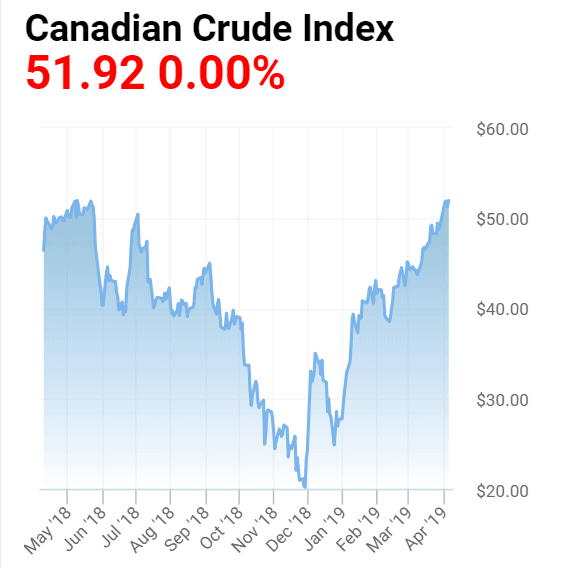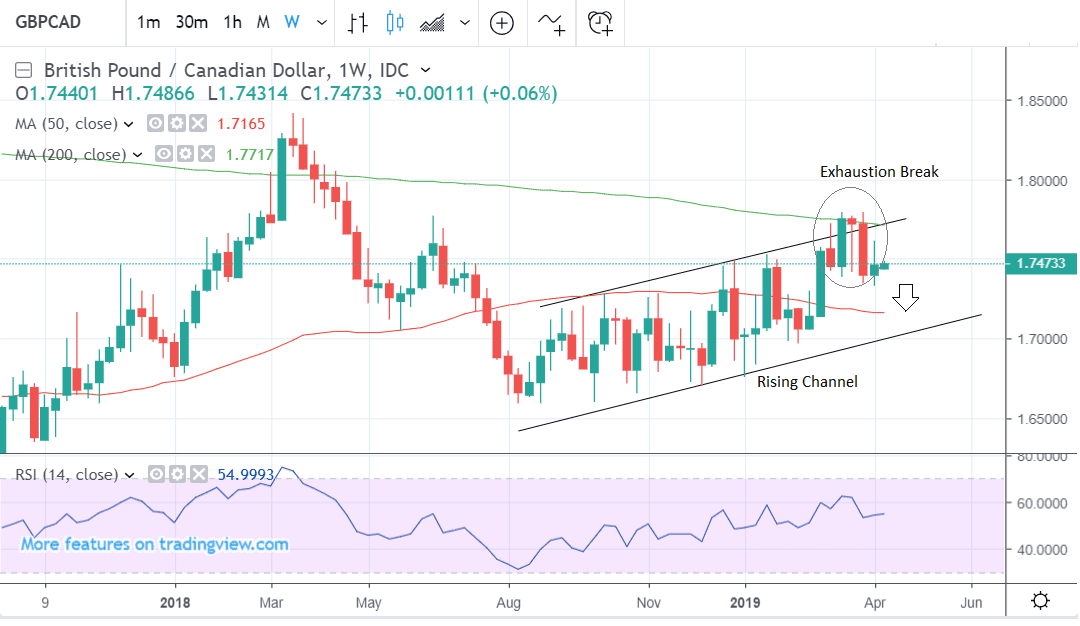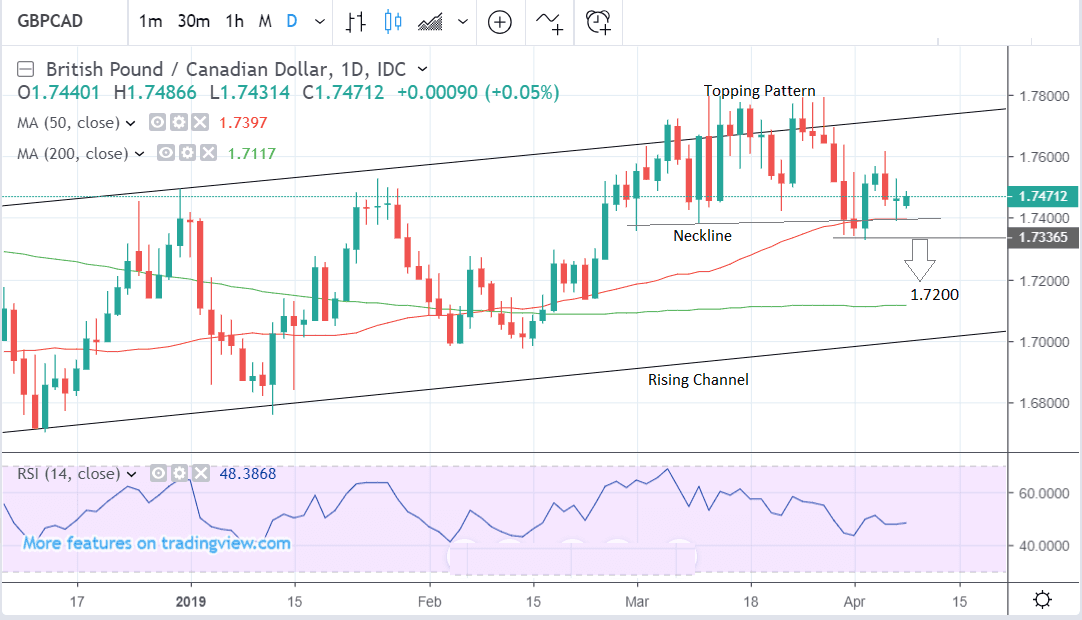Pound / Canadian Dollar 5-Day Forecast: GBP Looking Vulnerable After Possible ‘Exhaustion Break’

Image © Adobe Images
- GBP/CAD in decline after peaking at top of channel
- Possibility pair may have reversed trend
- Brexit main factor for GBP; housing for CAD
The Pound-to-Canadian Dollar rate is trading at 1.7471 at the start of the new week, a marginal three tenths of a cent higher than it ended the previous week.
The pair has seen a small rebound in the last few weeks as the Pound has marginally outperformed the Canadian Dollar. This was mainly as a result of the release of poor economic data from Canada, where employment data read below economists' expectations - since the Pound was volatile, but with little net gain, from Brexit gyrations.
From a technical outlook point-of-view, the bigger picture continues to show GBP/CAD possibly poised to weaken. The pair ran up in a channel during the second half of 2018 and then peaked in March when it broke temporarily out of the top of the channel and touched the 200-week MA. After that it reversed and started falling.
In our two previous week-aheads we discussed how the breakout could be interpreted as either a very bullish or very bearish sign. Sometimes upside breakouts from rising channel are signs of exhaustion and mark turning points in trend. And, indeed, since then the exchange rate has behaved quite bearishly since the break it suggests it was, in fact, probably an exhaustion break.
This interpretation now reinforces the downside bias, and the pair is now on its way down to the next target at 1.7200, with a break below the 1.7328 lows now providing confirmation.
Backing up this call is the bearish topping pattern which has formed on the daily chart. The recent break below the pattern’s neckline in the 1.74s has also now provided confirmation, with the next target at the aforesaid 1.7200.
Time to move your money? Get 3-5% more currency than your bank would offer by using the services of foreign exchange specialists at RationalFX. A specialist broker can deliver you an exchange rate closer to the real market rate, thereby saving you substantial quantities of currency. Find out more here.
* Advertisement
The Canadian Dollar: What to Watch this Week
In light of concerns about the Canadian residential housing market, probably the most important data release in the week ahead is going to be the new housing price index which is expected to continue showing a -0.1% fall month-on-month in February, when the data is released on Thursday, April 11, at 13.30 BST.
A recent report from the IMF highlighted risks to the Canadian housing market which would have a negative knock-on effect on GDP.
The report said the risks of a substantial price correction were now higher than they had been since the great financial crisis of 2008. Valuations were stretched following a boom in many of its cities which had pushed prices up to even more distorted levels than that experienced in the U.S.
Downside risks were high because of the reliance of Canadian metropolitan housing markets on foreign capital inflows which could falter in the event of a protracted global slowdown. Clearly a sharp drop in house prices would be negative for the Loonie both from a foreign capital inflows perspective and aggregate GDP point of view.
Another fundamental driver, historically speaking, of the Canadian Dollar is the price of crude oil, especially Canadian crude, which often trades at a discount to regular crude. The price of Canadian oil has risen steeply in 2019 after the Alberta government enforced production cuts to try to prop up prices, which had fallen to only $10 per barrel. This tactic now seems to have worked give the price has risen back up to above $50 pb.

Generally higher oil prices support the Loonie and vice versa for lower but the link between the two appears to have disconnected in March so oil may not be such a factor in the short-term until the correlation is restored.
“An examination of one-month correlations confirms that the CAD’s typically healthy relationship with oil prices broke down almost entirely early last month: correlations dropped from a near 60% daily average through February to negative correlations in its aftermath," says Neil Mellor, Senior Currency Strategist with BNY Mellon.
Part of the reason may be fears about production remaining low. News that pipeline operator Enbridge has said its pipeline 3 will not return to operation until after June 2020 from an initial expectation of end of 2019, has increased production fears, and whilst this will keep prices higher the benefits will be offset by lower volume of exports.
A sharp fall in demand from China is another concern. Part of the reason is the already mentioned five fold rise in prices which now means Canadian oil is not such a great bargain. But it could also be partly due to the standoff between the two nations over Canada’s arrest and extradition of Huawei’s commercial director.
So far in 2019, no tankers have been seen carrying oil to China whereas in 2018 a record 12 tankers did, according to a story in the Vancouver Sun.
The Pound: What to Watch
The Pound was supported ahead of the weekend on reports European Council President Donald Tusk will this week propose to European leaders they offer the UK a 12-month "flexible" Brexit delay.
However, on Friday Prime Minister Theresa May formally requested a delay to June 30.
If the European Council meeting on Wednesday does grant either of the two requests we expect Sterling to be supported as it ensures the UK will avoid a 'no deal' Brexit on Friday.
There are however reports France, Belgium and Spain see too much danger to the EU's integrity in offering a long extension, and the three countries are reportedly keen to only offer a short, two week extension that would allow both sides to prepare for a 'no deal'.
When we read this report on Friday night we immediately Tweeted a message to our readers that this is a significantly negative development that means the chance of a 'no deal' Brexit is substantial.
Remember, all 27 EU states have to sign off on whatever deal is offered to the UK and such opposition by core EU members cannot be ignored.
Germany is however reportedly open to Tusk's offer of a flexible extension as they are said to be keen to avoid a 'no deal' at all costs.
We feel that if France, Belgium and Spain win out, the UK parliament will face a crunch vote on Thursday that provides MPs a final chance to approve a deal.
The opportunity for parliament to vote for a delay to Brexit will have been entirely removed by the EU.
Thursday therefore really could be Sterling's 'crunch time'.
Much will of course depend on whether Labour and the Conservatives strike a deal that both parties can support in the House of Commons, if they do and a deal is voted through then we would expect a sharp rally in Sterling.
However, we note entrenched opposition within both the Labour and Conservative parliamentary parties against the two sides working for a deal, so even if a plan is agreed there is no guarantee it would be passed by a rebellious parliament.
On the 'hard data' front, the monthly GDP figure for February is the most important release. Currently no rise - or 0.0% - is forecast, which would mean a significant slowdown from the previous month’s 0.7%.
A slowdown in GDP would likely lead to downwards pressure for the Pound since it would make the UK less attractive to outside investors as a destination to put their capital to work.
GDP is out at 9.30 BST on Wednesday. The year-on-year figure is expected to come out at a higher 1.6%, revealing a better longer-term trend. The 3-month change figure is forecast to show a 0.2% rise, the same as previously.
The other key release is industrial production, out at the same time, and expected to show a -0.1% drop in February, versus the 0.6% rise in the previous month. This is an important contributor to GDP, so the release is also significant for the Pound for the same reasons.
The trade balance is also out at the same time. It showed a -£13.1bn deficit in the previous month of February and this is expected to fall marginally to -£12.8bn in February. Currencies often react to big changes in the trade balance as the market adjusts to a new equilibrium so a better-than-expected recovery might help Sterling and vice-versa for a fall.
Other data releases out at the same time are manufacturing production and construction output which is forecast to show a 0.8% rise, both in February.
Time to move your money? Get 3-5% more currency than your bank would offer by using the services of foreign exchange specialists at RationalFX. A specialist broker can deliver you an exchange rate closer to the real market rate, thereby saving you substantial quantities of currency. Find out more here.
* Advertisement











